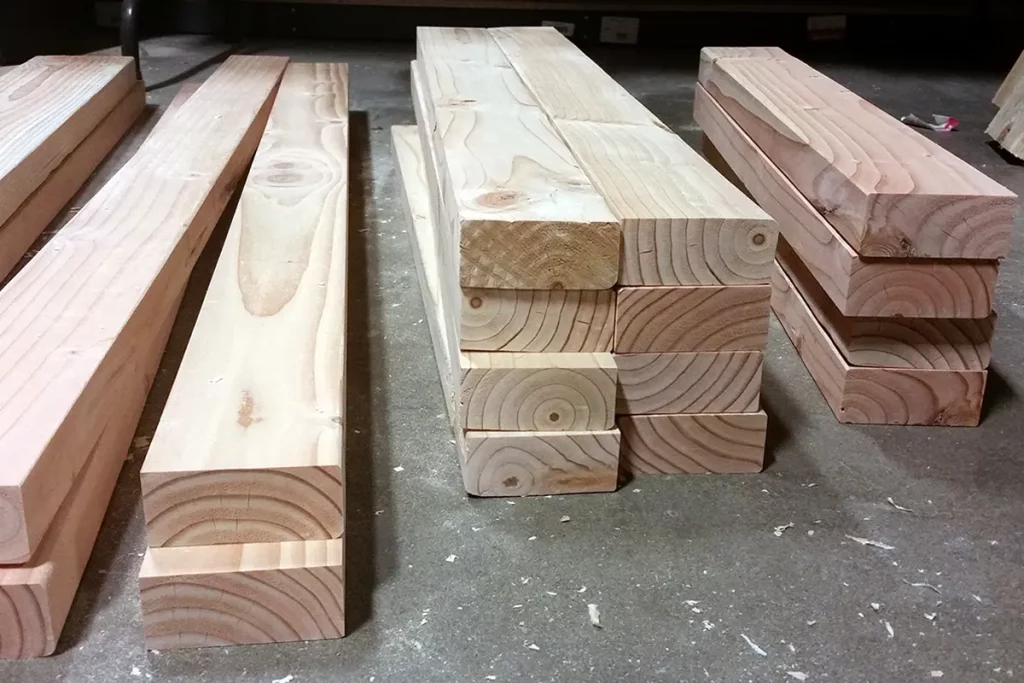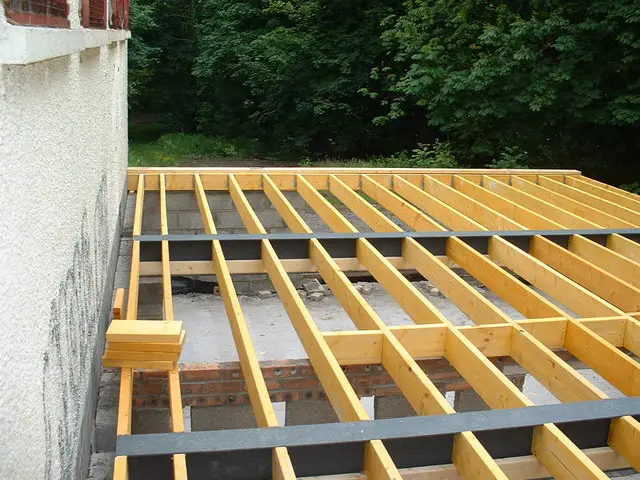Wood has been used to create shelter for nearly as long as humans have walked the earth. Fast forward to the 19th century and the creation of wood mills. This allowed for the accurate production of standard lumber sizes for commercial sales, leading to the lumber industry as we know it today.
Nominal vs Actual Lumber
Nominal lumber refers to the size of lumber after it has been rough-sawn, meaning the initial cuts made to divide a log into boards. The surface of these boards are rough and full of splinters and saw marks can usually be seen.
Actual lumber refers to the true size of the lumber after it has been seasoned (dried to reduce shrinkage) and planed smooth (or surfaced) to create a uniform product. This is much easier for carpenters to work with and more economical to transport. This is also often referred to as dressed lumber.
Lumber is most often referred to by its nominal dimensions. Nominal dimensions may seem misleading but are common. Measure your area rug and it’s likely slightly smaller than its listed size. Home and apartment listings might advertise a 10’x12′ bedroom, but it may have been rounded up a few inches to create a clean number.
Softwood Lumber
Softwood lumber is typically used structurally for framing, flooring, and creating plywood, sheathing, and paneling. It grows quickly and is economical. In North America, typical softwoods used for lumber production include pines, spruces, and firs.
1x Lumber Dimensions
| Nominal Dimensions | Actual or Dressed Dimensions (Inches) | Metric Dimensions (MM) |
| 1 x 2 | 3/4 x 1 1/2 | 19 x 38 |
| 1 x 3 | 3/4 x 2 1/2 | 19 x 64 |
| 1 x 4 | 3/4 x 3 1/2 | 19 x 89 |
| 1 x 6 | 3/4 x 5 1/2 | 19 x 140 |
| 1 x 8 | 3/4 x 7 1/4 | 19 x 184 |
| 1 x 10 | 3/4 x 9 1/4 | 19 x 235 |
| 1 x 12 | 3/4 x 11 1/4 | 19 x 286 |
2x Lumber Dimensions
| Nominal Dimensions | Actual or Dressed Dimensions (Inches) | Metric Dimensions (MM) |
| 2 x 2 | 1 1/2 x 1 1/2 | 38 x 38 |
| 2 x 3 | 1 1/2 x 2 1/2 | 38 x 64 |
| 2 x 4 | 1 1/2 x 3 1/2 | 38 x 89 |
| 2 x 6 | 1 1/2 x 5 1/2 | 38 x 140 |
| 2 x 8 | 1 1/2 x 7 1/4 | 38 x 184 |
| 2 x 10 | 1 1/2 x 9 1/4 | 38 x 235 |
| 2 x 12 | 1 1/2 x 11 1/4 | 38 x 286 |
4x Lumber Dimensions
| Nominal Dimensions | Actual or Dressed Dimensions (Inches) | Metric Dimensions (MM) |
| 4 x 4 | 3 1/2 x 3 1/2 | 89 x 89 |
| 4 x 6 | 3 1/2 x 5 1/2 | 89 x 140 |
| 4 x 8 | 3 1/2 x 7 1/4 | 89 x 184 |
| 4 x 10 | 3 1/2 x 9 1/4 | 89 x 235 |
| 4 x 12 | 3 1/2 x 11 1/4 | 89 x 286 |
6x Lumber Dimensions
| Nominal Dimensions | Actual or Dressed Dimensions (Inches) | Metric Dimensions (MM) |
| 6 x 6 | 5 1/2 x 5 1/2 | 140 x 140 |
| 6 x 8 | 5 1/2 x 7 1/4 | 140 x 184 |
| 6 x 10 | 5 1/2 x 9 1/4 | 140 x 235 |
Hardwood Lumber
Hardwood lumber is typically used for furniture, flooring, trim, millwork, and casework. Oak, maple, beech, black walnut, and poplar are all common hardwoods used in North America.
Softwood is surfaced on all four sides to create a clean rectangular shape. Hardwood, on the other hand, is typically surfaced or planed, on either one side (S1S) or two sides (S2S). The remaining two edges and not cut and planed. This allows the carpenter to create custom sizes and shapes that may not align with the typical lumber widths. “Live edges” (where the bark and exterior profile of the tree is intact) are also a popular feature of custom wood projects.
It’s common for big box retailers and some lumber yards to have hardwood cut and planed on all sides to make it easier for average homeowners and DIYers to purchase and work with the material.
Hardwood thickness is referred to in “quarters” of an inch. A 1-1/2″ thick board would be a 6/4 board (pronounced six-quarter).
Hardwood Lumber Dimensions
| Rough Thickness | Nominal Thickness | Actual Thickness – Surfaced 1 Side | Actual Thickness – Surfaced 2 Sides |
| 1/2 inch | – | 3/8 inch (9.5 mm) | 5/16 inch (7.9 mm) |
| 5/8 inch | – | 1/2 inch (13 mm) | 7/16 inch (11 mm) |
| 3/4 inch | – | 5/8 inch (16 mm) | 9/16 inch (14 mm) |
| 1 inch | 4/4 | 7/8 inch (22 mm) | 13/16 inch (21 mm) |
| 1 1/4 inch | 5/4 | 1 1/8 inch (29 mm) | 1 1/16 inch (27 mm) |
| 1 1/2 inch | 6/4 | 1 3/8 inch (35 mm) | 1 5/16 inch (33 mm) |
| 2 inches | 8/4 | 1 13/16 inch (46 mm) | 1 3/4 inch (44 mm) |
| 3 inches | 12/4 | 2 13/16 inch (71 mm) | 2 3/4 inch (70 mm) |
| 4 inches | 16/4 | 3 13/16 inch (97 mm) | 3 3/4 inch (95 mm) |
What’s the difference between lumber and timber?
Lumber is wood that has been sawn into common sizes for use in construction.
Timber usually refers to wood of a larger dimension that is often used as structural members. From a code standpoint, this is referred to as “heavy timber construction” and consists of timbers, usually greater than 5″ deep and wide, but depends on the timbers use (column vs rafter for example).
Timbers have a better resistance to fire than smaller lumber members because, as the wood burns, the char layer actually insulates and protects the inner wood from continuing to burn.
| Lumber Terminology | |
| Board | Less than 2″ thick |
| Dimensional Lumber | Between 2″ and 5″ |
| Timber | Greater than 5″ thick |
Header image source CC BY-SA 2.0


